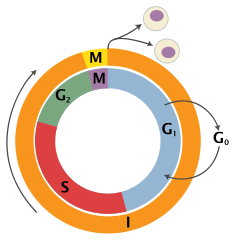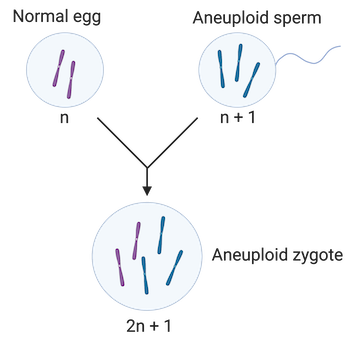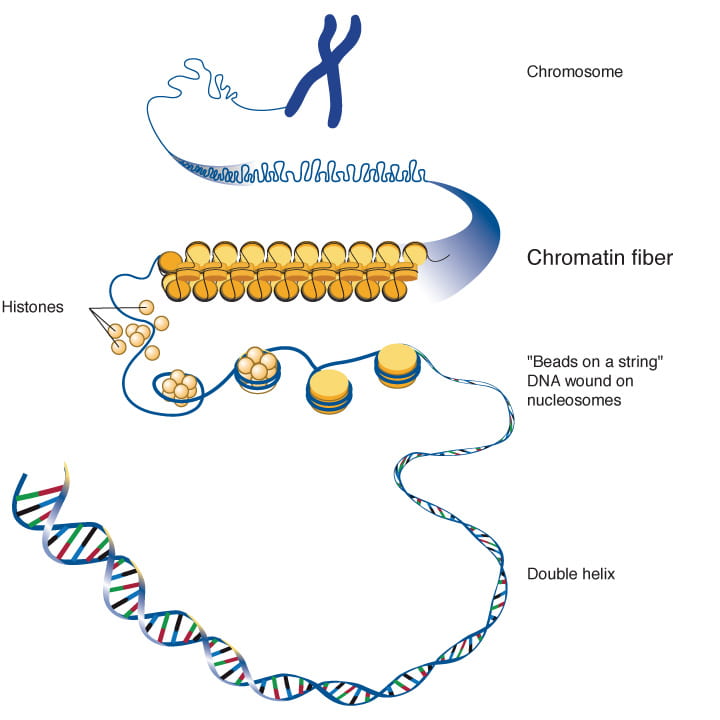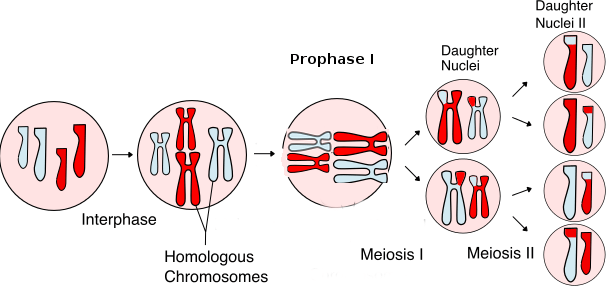Learning Objectives
- Use the terms chromosome, sister chromatid, homologous chromosome, diploid, haploid, and tetrad to describe the chromosomal makeup of a cell
- Compare and contrast mitosis and meiosis with respect to functions, outcomes, and behaviors of chromosomes
- Identify whether a cell is diploid or haploid using the chromosomal content
- Predict DNA content of cells in different phases of mitosis, meiosis, and the cell cycle
- Recall and describe the phases of the cell cycle, and predict outcomes if there is an error in a given stage of the cell cycle
- Identify events in meiosis that could cause chromosomal nondisjunction
The Cell Division Cycle

Cells reproduce genetically identical copies of themselves by cycles of cell growth and division. The cell cycle diagram on the left shows that a cell division cycle consists of 4 stages:
- G1 is the period after cell division, and before the start of DNA replication. Cells grow and monitor their environment to determine whether they should initiate another round of cell division.
- S is the period of DNA synthesis, where cells replicate their chromosomes.
- G2 is the period between the end of DNA replication and the start of cell division. Cells check to make sure DNA replication has successfully completed, and make any necessary repairs.
- M is the actual period of cell division, consisting of prophase, metaphase, anaphase, telophase, and cytokinesis.
Chromosomes
Chromosomes were first named by cytologists viewing dividing cells through a microscope. The modern definition of a chromosome now includes the function of heredity and the chemical composition. A chromosome is a DNA molecule that carries all or part of the hereditary information of an organism. In eukaryotic cells, the DNA is packaged with proteins in the nucleus and varies in structure and appearance at different parts of the cell cycle.
Chromosomes condense and become visible by light microscopy as eukaryotic cells enter mitosis or meiosis. During interphase (G1 + S + G2), chromosomes are fully or partially decondensed, in the form of chromatin, which consists of DNA wound around histone proteins (nucleosomes).
In G1, each chromosome is a single chromatid. In G2, after DNA replication in S phase, as cells enter mitotic prophase, each chromosome consists of a pair of identical sister chromatids, where each chromatid contains a linear DNA molecule that is identical to the joined sister. The sister chromatids are joined at their centromeres, as shown in the image below. A pair of sister chromatids is a single replicated chromosome, a single package of hereditary information.

Ploidy
Ploidy is the number of full sets chromosomes in a cell. Humans are diploid, meaning we have two copies of each chromosome. We inherited one copy of each chromosome from other our mother, and one copy of each from our father. Gametes (sperm cells or egg cells) are haploid, meaning that they have just one complete set of chromosomes.
Chromosomes that do not differ between males and females are called autosomes, and the chromosomes that differ between males and females are the sex chromosomes, X and Y for most mammals. Humans most commonly have 22 pairs of autosomes and 1 pair of sex chromosomes (XX or XY), for a total of 46 chromosomes. We say that humans have 2N = 46 chromosomes, where N = 23, or the haploid number of chromosomes.
Cells with complete sets of chromosomes are called euploid; cells with missing or extra chromosomes are called aneuploid. The most common aneuploid condition in people is variation in the number of sex chromosomes: XO (having just one copy of the X), XXX, or XYY. Having no X chromosome results in early embryonic death.
The two copies of a particular chromosome, such as chromosome 1, are called homologous. The karyotype image above shows the homologous pairs for all the autosomes. Homologous chromosomes are not identical to each other, unlike sister chromatids. They frequently have different variants of the same hereditary information, such as blue eye color vs brown eye color or blood type A versus blood type B.
Mitosis
Mitosis produces two daughter cells that are genetically identical to each other, and to the parental cell. A diploid cell starts with 2N chromosomes and 2X DNA content. After DNA replication, the cells is still genetically diploid (2N chromosome number), but has 4X DNA content because each chromosome has replicated its DNA. Each chromosome now consists of a joined pair of identical sister chromatids. During mitosis the sister chromatids separate and go to opposite ends of the dividing cell. Mitosis ends with 2 identical cells, each with 2N chromosomes and 2X DNA content. All eukaryotic cells replicate via mitosis, except germline cells that undergo meiosis (see below) to produce gametes (eggs and sperm).
Mitosis contains the following phases:
- prophase – chromosomes condense; each chromosome consists of a pair of identical sister chromatids joined at the centromere.
- metaphase – chromosomes line up at the middle of the cell, along the plane of cell division, pushed and pulled by microtubules of the spindle apparatus
- anaphase – sister chromatids separate and migrate towards opposite ends of the cell
- telophase – chromatids cluster at opposite ends of the cell and begin to decondense
- cytokinesis – the membrane pinches in to divide the two daughter cells
Here is a simplified diagram illustrating the overall process and products of mitosis:

Questions or points to ponder or note about the figure above (answers at bottom of page):
- are the two daughter cells the same or different from each other, and from the parent cell at the start?
- why does the cartoon illustration of the chromosomes change (from a single rod to joined double rods) after DNA replication, and again (back to single rods) during mitosis?
- does the figure show 2 different chromosomes or a single pair of homologous chromosomes?
- can haploid cells undergo mitosis? what about triploid cells (cells that have 3N chromosomes)?
This animation below shows the packaging of DNA and condensation of chromosomes as a cell undergoes mitosis.
The video narration has a major error at time 1:22: chromosomes exist throughout the entire cell cycle (at all times in a cell’s life); they are visible in their condensed form only during mitosis and meiosis.
Meiosis
This is a special sequence of 2 cell divisions that produces haploid gametes from diploid germline cells. It starts with a diploid cell that has undergone chromosomal DNA replication: 2N chromosomes, 4X DNA content. Two successive divisions, with no additional DNA replication, results in 4 haploid gametes: 1N chromosomes, 1X DNA content.
NOVA has a good interactive side-by-side comparison of mitosis and meiosis on this page: How cells divide
Meiosis sets the stage for Mendelian genetics. Students need to know that most of the genetics action occurs in the first meiotic division:
- homologous chromosomes pair up and align end-to-end (synapsis to form a tetrad, the structure formed by aligned, replicated homologs) in prophase I
- crossing over occurs between homologous chromosomes in prophase I, before chromosomes line up at the metaphase plate
- homologous chromosomes separate to daughter cells (sister chromatids do not separate) in the first division, creating haploid (1N) cells
- the separation of each pair of homologous chromosomes occurs independently, so all possible combinations of maternal and paternal chromosomes are possible in the two daughter cells – this is the basis of Mendel’s Law of Independent Assortment
- the first division is when daughter cells become functionally or genetically haploid
The last point appears to be the most difficult for students to grasp. Consider the X and Y chromosomes. They pair in prophase I, and then separate in the first division. The daughter cells of the first meiotic division have either an X or a Y; they don’t have both. Each cell now has only one sex chromosome, like making it a haploid cell.
One way of thinking about ploidy is the number of possible alleles for each gene a cell can have. Right after meiosis I, the homologous chromosomes have separated into different cells. Each homolog carries one copy of the gene, and each gene could be a different allele, but these two homologs are now in two different cells. Though it looks like there are two of each chromosome in each cell, these are duplicated chromosomes; ie, it is one chromosome which has been copied, so there is only one possible allele in the cell (just two copies of it).
The second meiotic division is where sister (duplicated) chromatids separate. It resembles mitosis of a haploid cell. At the start of the second division, each cell contains 1N chromosomes, each consisting of a pair of sister chromatids joined at the centromere.
Here is a simplified diagram illustrating the overall process and products of meiosis:
And here is a video that walks through the steps of meiosis:
It is very important that you recognize how and why cells become haploid after meiosis I.
To confirm for yourself that you understand meiosis, work through one or more of these interactive tutorials:
- The U. Arizona Cell Biology Project’s Meiosis tutorial has a click-through animation of meiosis, with 10 thought-provoking problem questions.
- Jung Choi’s interactive flash tutorial, programmed by Pearson, uses human chromosome 7, with wild type and cystic fibrosis alleles for CFTR, to track segregation through meiosis, with and without crossing over: Meiotic Segregation tutorial
Chromosomes, chromatids, what is the difference and how many chromosomes are there at different times of the cell cycle and after mitosis and meiosis?
Chromosomes by definition contain the DNA that makes up the fundamental genome of the cell. In a prokaryote, the genome is usually packaged into one circular chromosome consisting of a circular DNA molecule of a few million base pairs (Mbp). In eukaryotes, the genome is packaged into multiple linear chromosomes, each consisting of a linear DNA molecule of tens or hundreds of Mbp. Chromosomes exist at all different phases of the cell cycle. They condense and become visible to light microscopy in prophase of mitosis or meiosis, and they decondense during interphase, in the form of chromatin (DNA wrapped around nucleosomes, like “beads on a string”).
The chromosome number, N, in eukaryotes, refers to the number of chromosomes in a haploid cell, or gamete (sperm or egg cell). Diploid cells (all the cells in our body except our gametes) have 2N chromosomes, because a diploid organism is created by union of 2 gametes each containing 1N chromosomes. In terms of chromosome number (ploidy), it is useful to think of chromosomes as packages of genetic information. A pair of sister chromatids is one chromosome because it has genetic information (alleles) inherited from only one parent. A pair of homologous chromosomes, each consisting of a single chromatid in a daughter cell at the end of mitosis, has alleles from the father and from the mother, and counts as 2 chromosomes.
This chromosome number stays the same after chromosome replication during S phase: each chromosome entering cell division now consists of a pair of sister chromatids joined together at the centromere. Then in mitosis, the sister chromatids of each chromosome separate, so each daughter cell receives one chromatid from each chromosome. The result of mitosis is two identical daughter cells, genetically identical to the original cell, all having 2N chromosomes. So during a mitotic cell cycle, the DNA content per chromosome doubles during S phase (each chromosome starts as one chromatid, then becomes a pair of identical sister chromatids during S phase), but the chromosome number stays the same.
A chromatid, then, is a single chromosomal DNA molecule. The number of chromatids changes from 2X in G1 to 4X in G2 and back to 2X, but the number of chromosomes stays the same.
The chromosome number is reduced from 2N to 1N in the first meiotic division, and stays at 1N in the second meiotic division. Because homologous chromosomes separate in the first division, the daughter cells no longer have copies of each chromosome from both parents, so they have haploid genetic information, and a 1N chromosome number. The second meiotic division, where sister chromatids separate, is like mitosis. Chromosome number stays the same when sister chromatids separate.
Using the information above, compare these two simplified diagrams of mitosis and meiosis to visualize why cells are haploid after meiosis I. Specifically, compare the chromosomes in cells at the end of mitosis vs the end of meiosis I, recognizing that the diagram of mitosis tracks just a single pair of homologous chromosomes, whereas the diagram of meiosis tracks two pairs of homologous chromosomes (one long chromosome and short chromosome):

The video below is geared toward a high school audience, but it does present a helpful way for recognizing how many chromosomes are present in a cell (and thus the ploidy level of that cell). While watching, see if you can recognize why the products of meiosis 1 are haploid cells:
Answers to questions about the mitosis figure:
- The two daughter cells are the same as each other, and same as the parental cell
- Each rod represents a chromatid, and DNA replication results in two sister chromatids joined at their centromeres. Mitosis separates the sister chromatids.
- A single pair of homologous chromosomes. Red and blue are chromosomes inherited from the male and female parents.
- Any cell can divide by mitosis: haploid, triploid, even aneuploid cells.
Nondisjunction of chromosomes
This is excerpted from Khan Academy.
Disorders of chromosome number are caused by nondisjunction, which occurs when pairs of homologous chromosomes or sister chromatids fail to separate during meiosis I or II (or during mitosis).
The diagram below shows how nondisjunction can take place during meiosis I if homologous chromosomes don’t separate, and how this can lead to the production of aneuploid gametes (eggs or sperm):

Nondisjunction can also happen in meiosis II, with sister chromatids (instead of homologous chromosomes) failing to separate. Again, some gametes contain extra or missing chromosomes:

Finally, nondisjunction can happen during mitosis. In humans, chromosome changes due to nondisjunction during mitosis in body cells will not be passed on to children (because these cells don’t make sperm and eggs). But mitotic nondisjunction can cause other problems: cancer cells often have abnormal chromosome numbers.
When an aneuploid sperm or egg combines with a normal sperm or egg in fertilization, it makes a zygote that is also aneuploid. For instance, if a sperm cell with one extra chromosome (n + 1) combines with a normal egg cell (n), the resulting zygote, or one-celled embryo, will have a chromosome number of 2n +1.

Sustainable Development Goal

UN Sustainable Development Goal (SDG) 5: Gender Equality – Understanding cell growth and division, especially when generating gametes, is important in the study of developmental biology, reproductive biology, and chromosomal sex determination. This knowledge can not only help one understand the specific challenges certain sexes may face, but also the complicated nature of determining sex by chromosomes (vs. other traits, such as hormones), the difference between sex and gender, and the need to engage in scientifically-informed discussions for gender equality.




Here’s a nifty video of mitosis using fluorescence microscopy images. The condensed chromosomes glow red, and the microtubules of the mitotic spindle glow green.
https://twitter.com/BlackFinch/status/670338456309080065